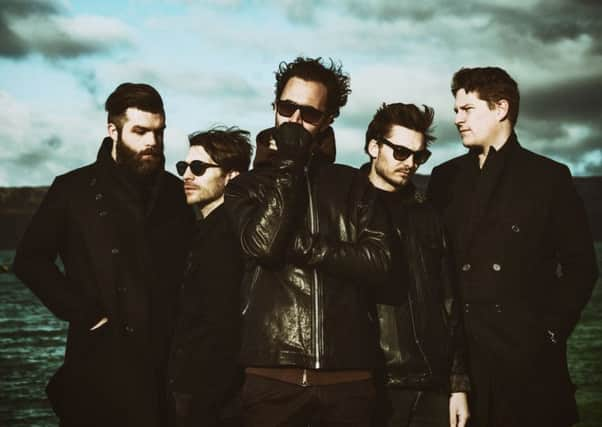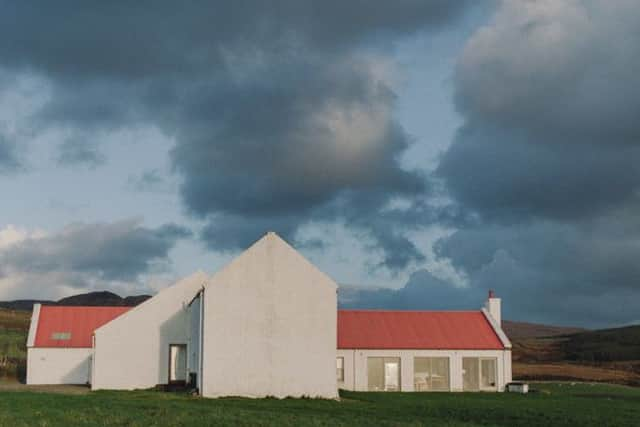Editors’ Tom Smith on his band’s refuge in Crear


ONCE there was a time, during the golden age of Aquarius, when it seemed as though every third coastal cottage in Scotland was occupied by hirsute hippie rockers who’d abandoned the distractions of the modern world to “get it together in the country”. These days, even the most bucolic-sounding album has probably been recorded in a busy metropolitan studio. Yet there are still some secret outposts offering refuge for escaped artisans. Crear, on the west coast of Scotland, is one such hideaway.
Surrounded by 200 acres of verdant terrain and extraordinary views to Jura, Islay and Gigha, it’s a stylishly renovated farm building where artists, writers, poets and musicians from all genres come looking for freedom to create and perform. It’s also a much sought-after wedding destination. And that’s thanks to Scottish pop-rockers Travis. After the success of their album The Invisible Band in 2001, Fran Healy and co were the first rock band to visit Crear when they entered its fortress of solitude to work on the follow-up, 12 Memories. Artistic director Kate Lithgow recalls: “It was literally the case that Travis were recording their album at Crear, and somebody asked if they could get married there. It wasn’t a member of Travis, it was a friend of theirs. They came to visit and asked if we’d consider doing a wedding, and it sort of snowballed from there. That wasn’t the original intention, but the weddings now support over 100 days of the arts a year.”
Advertisement
Hide AdAdvertisement
Hide AdWorking in association with funding body Enterprise Music Scotland, those 100 days are devoted to young musicians and artists in residence, who perform concerts and visit schools in the Argyll region. These endeavours are co-funded by Lithgow’s arts charity Space to Create, but the overheads involved in running the premises are paid for by its busy influx of nuptial gatherings. A wedding-cum-arts venue is an unusual proposition, but Lithgow appreciates its modest genius. “Although at the beginning I couldn’t quite put the two together, there is actually a connection,” she says. “Musicians play at every wedding and people want something to have as a special wedding present, so they might commission an artist or buy a piece of artwork. It all feeds in. It’s not uncommon for musicians who get married there to then come back and get support from the charity.”


The site was discovered in the late 1990s by Lithgow, a professional photographer, and acclaimed classical conductor and Crear’s musical adviser Harry Bicket, both of whom grew up in the nearby area. Following a lengthy renovation, it opened its doors in 2002, the year of Travis’ visit.
“It started as a slightly crazy idea,” says Lithgow. “As we’re all aware, there are many great ideas for many great arts projects, but very few of them make financial sense. But right from the beginning there were a lot of people who gave an amazing amount of support in kind, a lot of musicians, a lot of artists.”
The latest major rock act to record at Crear are Editors, the platinum-selling band from Birmingham whose successes in recent years include two UK No 1 albums. Their latest album, In Dream, is their first to be entirely self-produced. This inevitably required a slightly different form of discipline for the band.
“We’re pretty conscientious anyway, we work hard,” says lead vocalist and songwriter Tom Smith, “but the reason we went somewhere so remote and secluded was to be away from distraction. To have nothing else to do, to work longer hours on the material, because previously we’d rehearse and develop ideas in Birmingham, Monday to Friday, with most of us commuting. That’s how it’s worked for the last few records, but that process can take a year. So we wanted to put ourselves in the same building, sleep there and work there. We had a pile of songs to get through, and that’s what we were there to do.”
Although Crear doesn’t house recording facilities, the studio space allows for equipment to be installed there. So in the autumn of 2014, Editors arrived to record material which, cushioned with dreamy synthesizers, Smith’s falsetto and a haunting cameo from Slowdive’s Rachel Goswell, sounds more ethereal than anything they’ve recorded before.
Did their surroundings influence the album’s sound?
“It’s hard to draw direct pointers from the setting to the music,” says Smith, “there are no bagpipes or any clichés like that, but it was a stunningly beautiful place. The window was the whole width of the room, you’d look out there to the ocean and the island of Jura and you’d see the weather just rolling over you. At that time of year in Scotland you get everything in the space of a few minutes, we even had tail-ends of hurricanes. There’s a kind of cosmic, colourful nature to some of the synth sounds we were using, and it did feel connected to that spiritual and cosmic view.”
Lithgow notes that musicians tend to finish their work more quickly at Crear due to the focused intensity of the experience. “We have very limited mobile range, we don’t have television reception, people aren’t going out and having to deal with their day-to-day, they have no responsibility for anything except for making the work.”
Advertisement
Hide AdAdvertisement
Hide AdShe’s particularly proud of Crear’s open-door, hands-off policy regarding artists of any kind: ars gratia artis, complete with sheep, beaches and gorgeous ocean views.
“What I think is really interesting is bringing people from different art forms together and with no expectations of an outcome,” she says. “We’ve introduced quite a lot of people to each other, but with no pressure that they have to produce a piece of work together. I know a lot of people might say that they’re not really working, but from a creative side maybe they just have to sit on a beach for five days and then they’ll go back to the studio and create something amazing. It’s an abstract process that you cannot quantify.”
Although Lithgow welcomes any disciplined rock musician who cares to live and work there, Crear is still more associated with music from the classical sphere. It’s a global enterprise, too.
Scottish classical pianist Malcolm Martineau, renowned as one of the world’s finest recital accompanists, often hosts master-classes at Crear, most of which are attended by musicians from around the world.
Says Lithgow: “I was really conscious from the beginning that, although we’re very remote on the west coast of Scotland, there’s no reason why we couldn’t attract people on an international basis. The fact we’re on the west coast of Scotland is fantastic, but at the same time it’s almost secondary.”
Despite Crear’s initial goal of being a crucible for musicians with a Scottish connection, Lithgow says it attracts more people from overseas these days. So the far-flung location isn’t an issue for artists living thousands of miles away? “It’s an issue for people living in Helensburgh,” she laughs, “when it apparently seems like a long way to go. But if you’re coming from Moscow or Sydney it makes no difference at all.”
Twitter: @paulwhitelaw
• More information on Crear can be found at www.crear.co.uk. In Dream by Editors is released on Friday, www.editorsofficial.com